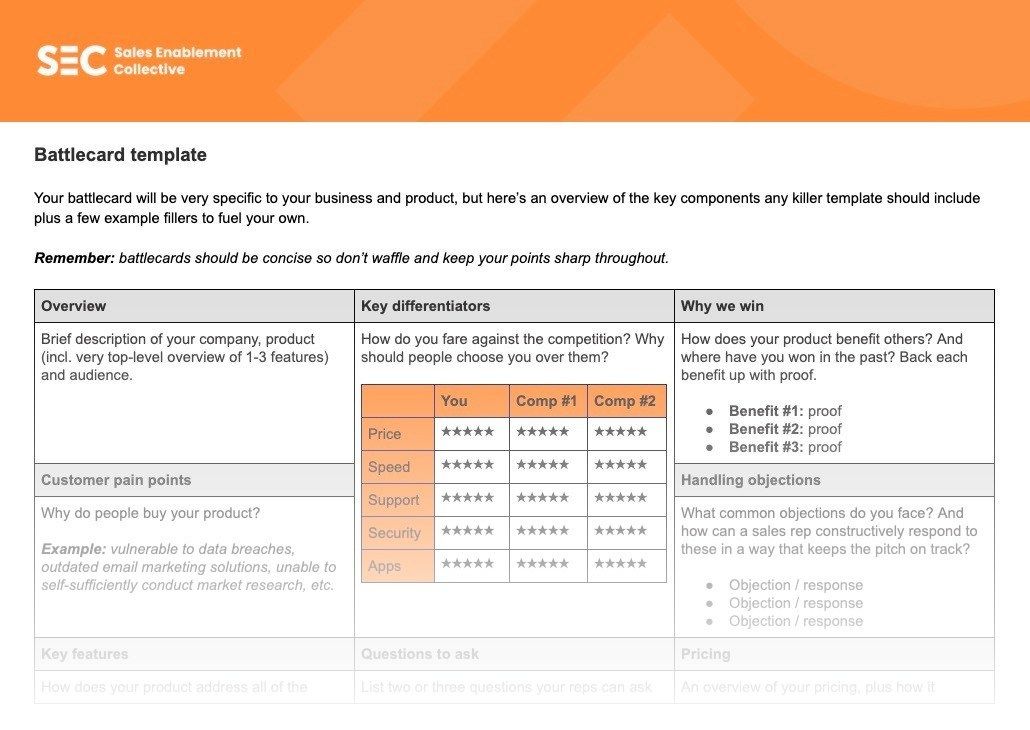Good sales enablement content helps reps to better understand their product portfolio; reinforce training and coaching initiatives; engage customers and effectively communicate benefits; and put the offering into context.
That's a lot of info, right? This is where battlecards come in.
A sales battlecard provides a concise, at-a-glance summary of your value proposition, answers to common customer queries and explains competitive differentiators.
Here's the need-to-know.
What is a battlecard?
Battlecards are concise, actionable summaries of your product, the market, existing customers, and the competition, and their job is to equip your sales team with quick-fire responses to questions, queries, or objections a customer might have.
What to include in a battlecard
Your battlecard should be specific to your product, and include sections focusing on:
- Company/product overview
- Customer pain points
- Key features
- Key differentiators
- Why your product or service is the best on the market
- A script to handle customer objections
- Questions to ask the prospect
- Pricing
- Third-party validation
- Relevant customers
These features will help you create a thorough battlecard that’s relevant for your product. Let’s take a look at each feature in further detail:
Overview
The overview is a brief description of your company, your product, and what you're offering. Keep it punchy; 2-3 sentences is long enough.
Customer pain points
In this section, you need to address why people buy your product.
In the example below, the company sells health insurance to businesses. One of their customer pain points is that employees can't afford high deductible plans.
Key features
After identifying your customer’s pain points, you need to demonstrate how your product addresses them.
In the example above we looked at how most employees couldn't afford health insurance, and how this impacts their health and wellbeing.
In this section of the battlecard, not only would you highlight how you can successfully help your customer address any health concerns, but you’d also point out how offering employees your health care plan would ensure a healthier and more productive workforce.
Key differentiators
This is where you match your product up against your competitors.
For example, if you’re offering a software solution, is your product more speedy? Does it have more features? Is your customer support better?
A handy grid format will help your sales team answer these questions quickly and confidently.
Why do you win?
In this section, you’ll need to know what’s important to your potential customers.
For example, is it the price? Customer service? Security? If you don’t know this information already, conduct some customer and market research to give you a thorough understanding of your customers and what their needs are.
List the relevant benefits your product provides and back it up with specifics. Use statistics, numbers, and real-life success stories.
Handling objections
Sometimes your sales team will face objections when pitching your product. You need to help them respond constructively and keep their pitch on track.
In this section, list your top three or four objections and script a response your sales team can refer to when they're met with these common obstacles.

Questions to ask
Here, list two or three questions your reps can ask the prospective customer to best position your product.
For example: “how do you feel about your current solution?” is a good starting point. This question allows your sales reps to differentiate your product from the competitors’.
Then, follow up with: “what’s the most frustrating thing about your current solution?” This question gives your reps insight into the prospect’s pain points and enables them to effectively position your product as the solution.
Pricing
Product pricing will always play a crucial role in your customers' final buying decisions.
Your battlecard must include a section outlining your pricing, and how you match up against your main competitors. Make sure your sales reps have everything at their disposal to answer any questions about pricing accurately and confidently.
Tip: Conducting competitive intelligence will help you keep an eye on your competitors’ pricing and update your content, so your sales reps don’t provide out-of-date information.
'Quick tips' section
Here’s where you need to make a few short notes about how your sales rep can get the most out of the call.
For example, it may be necessary to list a couple of questions you’d like your rep to ask, such as: “Ask how many contacts they have” or “Find out what their current solution is early on.”
Third-party validation
Reputable customer testimonials or endorsements are priceless; they can give your product credibility and provide an insight into what the prospect can expect if they decide to invest in your solution.
This section needs to shine the spotlight on what great things your existing customers are saying about you.
If a well-established, internationally recognized brand has provided a review, use their quotes. This could include a comment a customer made about how much quicker they completed a task with your solution, in comparison to one of your competitors’ products.
Refer to relevant customers
Give your prospective customer FOMO by reeling off the companies you already have as customers. However, be sure to keep it relevant.
For example, an SME will be more likely to relate to another SME over a Fortune 500 company.

Tips for creating battlecards
When planned and executed correctly, battlecards can play a significant role in your sales success.
With this in mind, we asked some professionals who use them in the wild for their tips on creating effective battlecards, and how they use them in their respective companies.
“I like to start with a SWOT for each competitor. I try honestly to assess their strengths, weaknesses, etc. I keep it pretty simple but I find it is a great starting point before building a battlecard.”
Martin Bakal, Product Marketing Director and Evangelist at OpenLegacy
“Firstly, consider your audience. How can you amplify the value of your research to cover not just sales processes, but product and leadership strategy?
“You also need to include impacts to your go-to-market strategy and predictions for their future go-to-market strategy, customer segmentation, and product.
“Get in the weeds with pricing, packaging, and value delivery. Don’t just look at the perfect price point, but consider the value from your target customer’s perspective.
“Finally, include quotes where possible, and feedback from a customer that a) chose a competitor over you, and b) chose you over a competitor.”
Fiona Finn, Director of Product Marketing at Unbounce
“Communicate internally and survey your sales team to understand who they're actually competing against and also pull in win/loss analysis to enhance your battlecard.
“Also, spell out how your company wins against each competitor so it's easy for sales to get what they need quickly.”
Jaclyn Rose, Staff Product Marketing Manager at HealthJoy
Sales battlecard template
If you're an SEC member, head over to your templates & frameworks library, where you'll find a comprehensive battlecard template ready for you to download and customize.
Not a member yet? Find out what you're missing (not just templates, but 100s of hours of expert talks from our events, exclusive content from sales enablement professionals at big brands, and... you'll see)...



